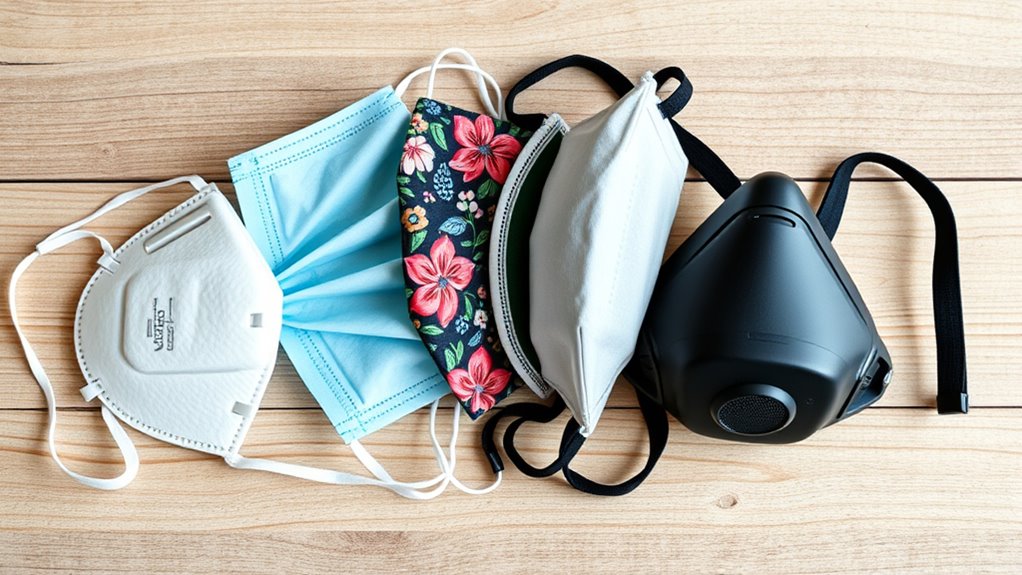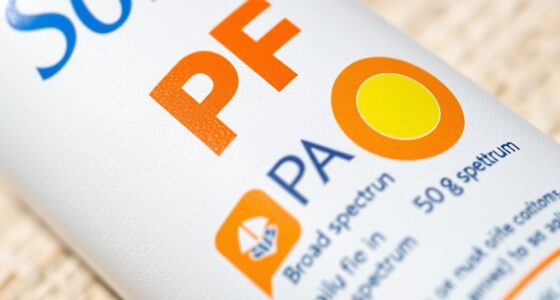Choosing the right face mask depends on your environment and activity. Cloth masks are great for daily outdoor errands—they’re washable, affordable, and customizable. Surgical masks work well for medical settings or crowded spaces, offering reliable droplet protection. For high-risk situations, like healthcare or industrial work, options like N95s or KN95s provide better filtration. Knowing when and why to use each type can keep you safer—stick around to discover more about their specific uses.
Key Takeaways
- Cloth masks are suitable for everyday low-risk activities and are reusable, customizable, and environmentally friendly.
- Surgical masks are ideal for medical settings, caring for the ill, or crowded public spaces, providing droplet protection.
- N95 respirators offer high filtration efficiency (95%) and require proper fit and seal for maximum protection.
- KN95 and KF94 masks provide high filtration (around 94-95%) and are used in high-risk environments with proper disposal.
- Proper mask fit, seal, and appropriate selection based on environment and activity are essential for maximum effectiveness.
Cloth Masks: Benefits and Suitable Uses
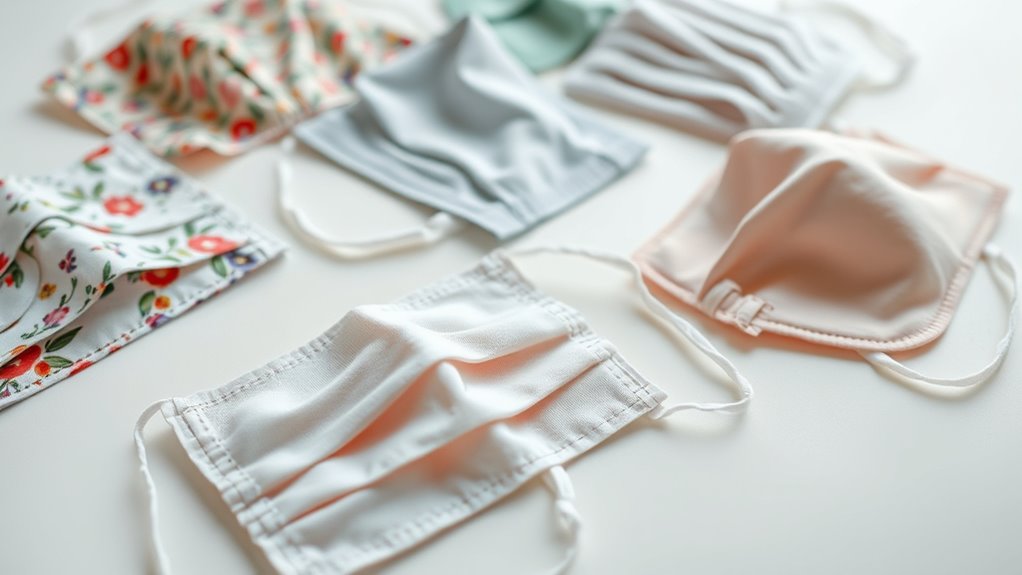
Cloth masks are a popular choice because they are reusable, affordable, and easy to customize. You can choose masks made from reusable materials like cotton or linen, which are breathable and washable, making them environmentally friendly and cost-effective. When selecting a cloth mask, fashion considerations come into play—you’re free to match your mask to your outfit or personal style, adding a touch of individuality. Cloth masks are suitable for everyday use in low-risk environments, like running errands or walking outdoors. They’re not designed for medical settings but serve well for general public use when combined with good hygiene practices. By choosing a stylish, well-made cloth mask, you stay protected while expressing your personality. Additionally, understanding the different mask types can help you select the best option for your specific needs.
Surgical Masks: Features and Appropriate Situations
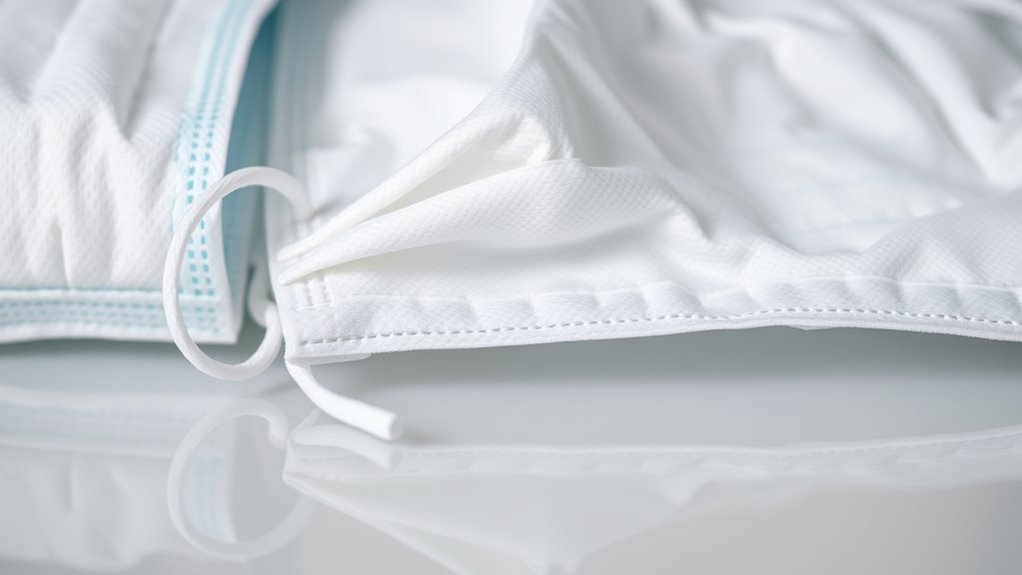
Surgical masks are designed to provide a reliable barrier against droplets and large particles, making them a common choice in healthcare and public settings. Their mask material typically includes multiple layers of non-woven fabric, which helps filter out contaminants while allowing breathability. Proper mask maintenance is essential; you should dispose of single-use masks after use and avoid touching the front surface to prevent contamination. When worn correctly, surgical masks effectively reduce the spread of infectious agents, especially in environments where close contact occurs. They’re most appropriate during medical procedures, when caring for someone ill, or in crowded public spaces. Remember, these masks are intended for one-time use and should be replaced regularly to guarantee maximum protection and hygiene. Material composition plays a significant role in their effectiveness against airborne particles.
N95 Respirators: Protection Level and Proper Usage

N95 respirators meet strict filtration efficiency standards, blocking at least 95% of airborne particles. To guarantee maximum protection, you need to wear the mask with a proper fit and a tight seal around your face. If the seal isn’t secure, your protection drops considerably, so proper fitting is essential. Regularly inspecting and maintaining your masks can ensure continued effectiveness, especially if they are part of your appliance maintenance plans for safety.
Filtration Efficiency Standards
Understanding filtration efficiency standards is essential for choosing the right mask for protection. These standards, established through rigorous testing, determine how well a mask can filter out airborne particles. For example, N95 respirators meet specific filtration standards, filtering at least 95% of particles as small as 0.3 microns. Mask certification guarantees the product has passed national or international safety requirements, giving you confidence in its protective capability. When selecting a mask, check for certification labels like NIOSH for N95s. Keep in mind that masks with higher filtration standards provide better protection against airborne contaminants. However, even the best mask won’t be effective if it doesn’t fit properly, which is why understanding these standards helps you make an informed decision for your safety. Additionally, proper mask fit and seal are crucial factors in ensuring maximum protection.
Proper Fit and Seal
A proper fit and seal are essential for maximizing the protective benefits of N95 respirators. To achieve this, guarantee the mask fits snugly against your face without gaps, especially around the nose and chin. Regular mask maintenance involves checking for tears or damage and adjusting straps for a secure fit. Proper storage techniques help preserve the respirator’s integrity; keep it in a clean, dry place away from contaminants when not in use. Avoid crushing or bending the mask, as deformation can compromise the seal. When donning the respirator, perform a fit check—inhale sharply to ensure it stays sealed. Consistent maintenance, correct storage, and proper donning techniques ensure your N95 provides ideal protection. Additionally, understanding filter maintenance and proper disposal methods can further enhance the mask’s effectiveness and safety over time.
KN95 and KF94 Masks: Differences and When to Wear Them
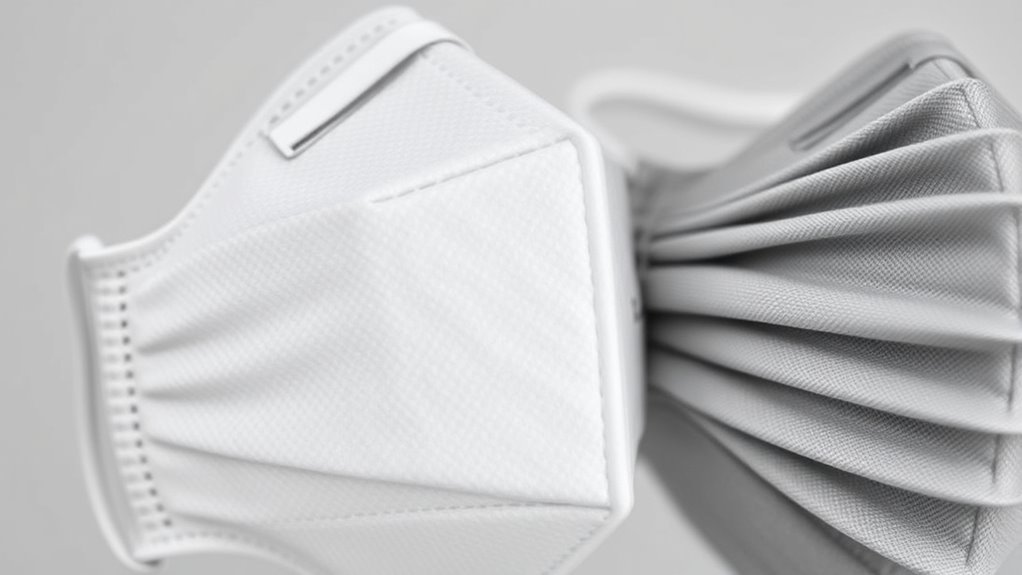
KN95 and KF94 masks offer high filtration efficiency, but they differ in fit and seal quality. Knowing when to wear each depends on understanding their performance, proper fit, and ideal situations. Let’s compare their filtration, fit, and best use cases to help you choose the right mask. Additionally, selecting a mask that fosters active listening and empathy ensures better protection and comfort during prolonged use.
Filtration Efficiency Comparison
When comparing filtration efficiency, KN95 and KF94 masks stand out as popular options, each designed to block airborne particles effectively. Both masks provide high filtration levels, with KN95 masks filtering about 95% of particles and KF94 masks around 94%. While their filtration capabilities are comparable, material breathability differs. KF94 masks typically use lighter, more breathable materials, enhancing mask comfort during extended wear. KN95 masks, on the other hand, may feel slightly less breathable due to denser materials, but they still offer excellent protection. Your choice depends on your needs—if comfort and breathability are priorities, KF94 might be preferable, especially for long periods. However, both masks deliver reliable filtration, making them suitable for various situations where high protection is essential. Sustainable design practices also influence the choice of materials used in mask manufacturing, emphasizing the importance of environmentally conscious options.
Proper Fit and Seal
Since a proper fit and seal are vital for maximum protection, it’s important to understand how KN95 and KF94 masks differ in this aspect. Your face shape plays a key role in mask comfort and effectiveness. KN95 masks tend to fit snugly around the nose and cheeks, but some face shapes may find them less comfortable if the seal isn’t tight enough. KF94 masks often have a slightly more flexible fit, accommodating diverse face shapes better, which can enhance comfort without sacrificing seal. Ensuring the mask molds well to your face helps prevent gaps, which is essential for protection. Proper mask fit is a critical factor in achieving the best possible safety. When choosing between the two, consider how each mask conforms to your face shape for ideal fit and comfort, ensuring a secure seal every time.
Suitable Usage Scenarios
Choosing the right mask depends on your specific environment and safety needs. KN95 and KF94 masks are ideal when you face higher risks of airborne particles, such as in crowded or indoor settings. Use them when you need enhanced filtration for protection against viruses, pollutants, or allergens. These masks are designed for single use, so proper face mask disposal is vital to prevent contamination. Be mindful of their environmental impact; consider recycling options if available or opting for masks with biodegradable materials. In less risky environments, cloth masks may suffice, but for high-exposure scenarios, KN95 and KF94 masks provide better safety. Always select masks suited to your environment to guarantee maximum protection and minimize unnecessary waste. Regular assessment of your surroundings can help determine when upgraded space organization or protective gear is necessary to maintain safety and efficiency.
Cloth Masks With Filters: Enhancing Protection
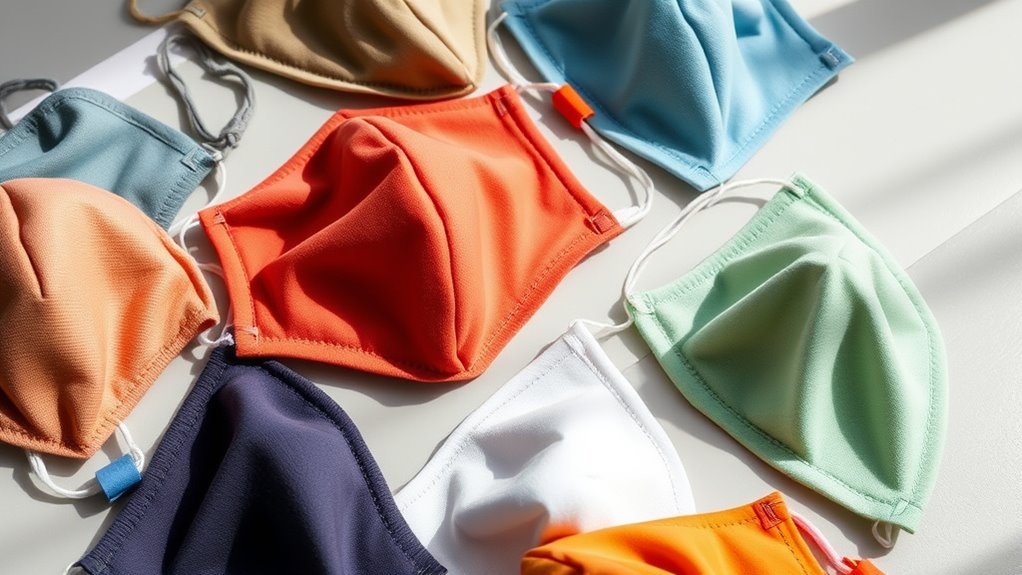
Adding a filter to your cloth mask can substantially boost its protective capabilities. It enhances filtration without sacrificing fabric breathability, keeping you comfortable during extended wear. These masks strike a good balance between protection and mask comfort, making them ideal for everyday use. To choose the right filter, consider materials like HEPA filters or activated carbon inserts that fit snugly without restricting airflow. Here’s a quick comparison:
| Filter Type | Benefits | Drawbacks |
|---|---|---|
| Surgical Mask Filter | Good filtration, easy to replace | Slightly reduces breathability |
| Activated Carbon | Adds odor control, extra filtration | May decrease airflow slightly |
| HEPA Filter | High-efficiency, strong protection | Can be less breathable |
| Cloth Filter Sleeve | Customizable, reusable | Needs regular cleaning |
| Coffee Filter | Inexpensive, accessible | Limited effectiveness |
Choose wisely to maximize protection without sacrificing comfort.
Specialty Masks: Use Cases for Different Environments
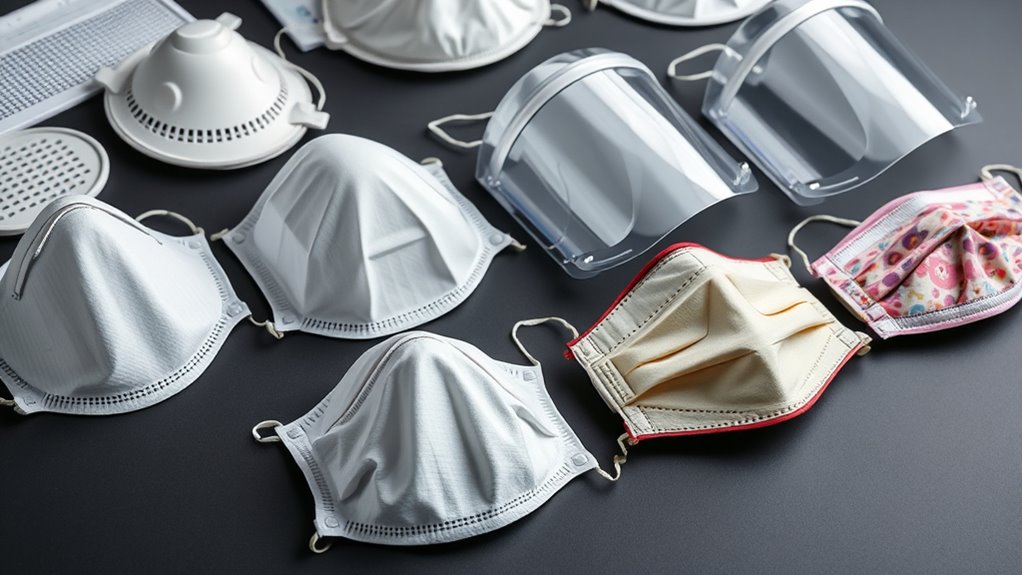
Different environments demand different levels of protection, and specialized masks are designed to meet these unique needs. In medical settings, you need masks that block pathogens effectively, like N95 respirators, to protect patients and staff. In industrial environments, masks must shield you from dust, chemicals, or fumes, such as powered air-purifying respirators (PAPRs).
Consider these scenarios:
- Working in a hospital, you rely on high-filtration masks to prevent infection spread.
- Handling hazardous materials in factories, you need masks that filter out dangerous particles.
- In emergency response, you require masks that adapt quickly to varying airborne threats.
Specialty masks ensure your safety, tailored to the environment’s specific risks.
Understanding different mask types can help you choose the appropriate protective equipment for each environment.
Choosing the Right Mask Based on Activity and Risk
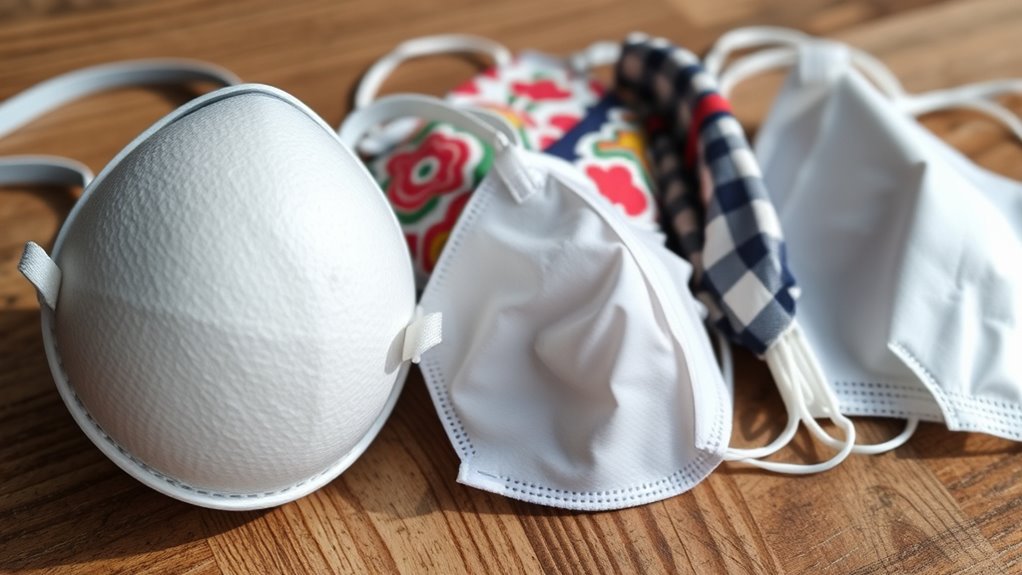
Selecting the appropriate mask depends on the activity you’re performing and the associated risk level. For high-risk situations, like healthcare settings, opt for masks made of multiple layers of effective mask materials, such as N95s or respirators, which filter airborne particles thoroughly. If you’re outdoors or in low-risk environments, a well-fitted cloth mask made from breathable fabrics can suffice. Consider cultural preferences, too, which influence mask styles and acceptance. For example, some cultures prefer masks with specific materials or designs that blend with traditional attire. Always match your mask choice to the activity’s risk and your comfort. Proper fit and material selection are essential for protection, so choose wisely based on the environment and your personal needs. Additionally, understanding mask types can help you select the most suitable option for your situation.
Frequently Asked Questions
How Often Should I Replace My Face Mask?
You should replace your face mask regularly to guarantee mask longevity and maintain its effectiveness. Generally, cloth masks can be washed and reused up to 30 times, but check the material durability—some fabrics wear out sooner. Disposable masks, like surgical masks, should be discarded after one use. Keep an eye on signs of wear, such as fraying or loss of shape, and replace your mask promptly to stay protected.
Can Masks Be Reused Safely After Washing?
Yes, you can reuse masks safely after washing if you choose the right mask material and washing methods. Imagine your mask as a shield; gentle hand washing with soap and warm water keeps it clean and maintains its integrity. Avoid harsh detergents or machine washing for delicate fabrics. Air dry thoroughly, ensuring no moisture remains, so your mask stays effective and safe for multiple uses.
Are Masks Effective Against All Types of Airborne Pathogens?
Masks are effective against many airborne transmission threats, but their filtration capacity varies. While high-quality masks like N95s block most airborne pathogens, cloth masks may be less effective, especially against smaller particles. You should choose a mask based on the specific airborne transmission risk. Proper fit and filtration are essential; no mask offers 100% protection. Always combine mask use with other safety measures for the best defense.
How Do I Know if My Mask Fits Properly?
Sure, because a loose mask is like a sieve—what’s the point? To check your proper fit, do a seal check every time you wear it. Cover the mask with your hands, inhale gently, and see if it pulls inward. If you feel air escaping around the edges, it’s not fitting right. Adjust the nosepiece and straps until you get a snug seal, ensuring maximum protection.
Do Masks Protect Against Pollution and Allergens?
Masks can help protect you against pollution and allergens if they’re designed for pollution prevention and allergen filtration. Look for masks with high-efficiency filters, like N95s, which block tiny particles. When you wear them properly, they reduce your exposure to airborne pollutants and allergens. Keep your mask clean and fit well to maximize protection, especially in polluted environments or areas with high allergen levels.
Conclusion
By understanding different mask types and their tailored tasks, you can confidently choose the correct cover for comfort and containment. Cloth, surgical, N95, and specialty masks each serve a specific purpose, providing protection in various environments. When you weigh activity, exposure, and ease, you’ll find the perfect fit. Remember, your mask’s mission is to minimize risk, so select smartly, stay safe, and stay suited for the situation.
